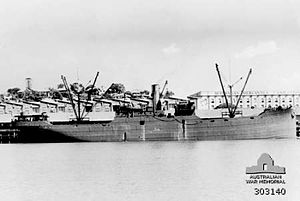 SS Coast Farmer, the SS Coast Trader sister ship
| |
| History | |
|---|---|
| Name |
|
| Owner |
|
| Port of registry | New York, New York( |
| Builder | Submarine Boat Corporation, Newark |
| Yard number | 108 |
| Laid down | 30 September 1919 |
| Launched | January 1920 |
| Completed | May 1920 |
| Identification | US Official Number 219588 |
| Fate | Sunk by I-26 in 1942 |
| General characteristics | |
| Type | EFC Design 1023, postwar commercial completion |
| Tonnage | |
| Displacement | 7,615 tons |
| Length |
|
| Beam | 46 ft (14.0 m) |
| Draft | 23 ft (7.0 m) |
| Depth | 28 ft 6 in (8.7 m) molded |
| Installed power | 2 Babcock & Wilcox water tube boilers, 1,500 hp (1,100 kW) |
| Propulsion | Westinghouse steam turbine, one quadruple-blade propeller |
| Speed | 10.5 knots (19.4 km/h; 12.1 mph) |
| Crew | 57 |
SS Coast Trader was built as the cargo ship SS Holyoke Bridge in 1920 by the Submarine Boat Company in Newark, New Jersey. The Coast Trader was torpedoed and sank 35 nautical miles (65 km; 40 mi) southwest of Cape Flattery, off the Strait of Juan de Fuca in U.S. state of Washington by the Japanese submarine I-26. Survivors were rescued by schooner Virginia I and HMCS Edmundston. She rests on the ocean floor at (48°19′N 125°40′W / 48.317°N 125.667°W).[1]
- ^ "Imperial Submarines". Combinedfleet.com. Retrieved 17 October 2022.